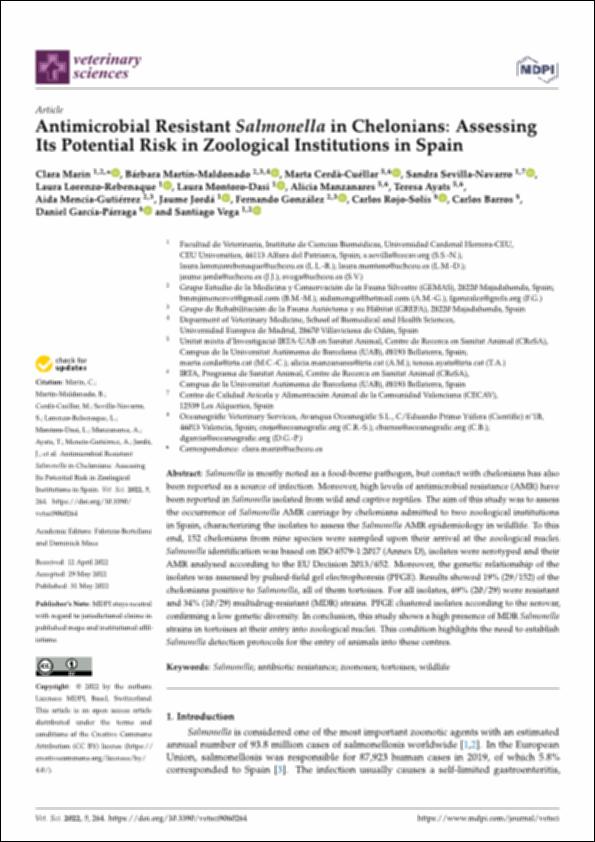Please use this identifier to cite or link to this item:
http://hdl.handle.net/10637/13974Antimicrobial resistant "Salmonella" in chelonians : assessing its potential risk in zoological institutions in Spain
| Title: | Antimicrobial resistant "Salmonella" in chelonians : assessing its potential risk in zoological institutions in Spain |
| Authors : | Marín Orenga, Clara Martín Maldonado, Bárbara Cerdà Cuéllar, Marta Sevilla Navarro, Sandra Lorenzo Rebenaque, Laura Montoro Dasí, Laura Jordá Moret, Jaume Vicent Vega García, Santiago |
| Keywords: | Zoonosis.; Zoonoses.; Turtles - Communicable diseases.; Bacterias - Resistencia a los medicamentos.; Drug resistance in microorganisms.; Salmonela - Resistencia a los medicamentos.; Drug resistance in Salmonella.; Tortugas - Enfermedades infecciosas. |
| Publisher: | MDPI |
| Citation: | Marin, C., Martín-Maldonado, B., Cerdà-Cuéllar, M., Sevilla-Navarro, S., Lorenzo-Rebenaque, L., Montoro-Dasi, L., Manzanares, A., et al. (2022). Antimicrobial resistant "Salmonella" in chelonians: assessing its potential risk in zoological institutions in Spain. Veterinary Sciences, vol. 9, i. 6 (31 may.), art. 264. DOI: http://dx.doi.org/10.3390/vetsci9060264 |
| Abstract: | Salmonella is mostly noted as a food-borne pathogen, but contact with chelonians has also been reported as a source of infection. Moreover, high levels of antimicrobial resistance (AMR) have been reported in Salmonella isolated from wild and captive reptiles. The aim of this study was to assess the occurrence of Salmonella AMR carriage by chelonians admitted to two zoological institutions in Spain, characterizing the isolates to assess the Salmonella AMR epidemiology in wildlife. To this end, 152 chelonians from nine species were sampled upon their arrival at the zoological nuclei. Salmonella identification was based on ISO 6579-1:2017 (Annex D), isolates were serotyped and their AMR analysed according to the EU Decision 2013/652. Moreover, the genetic relationship of the isolates was assessed by pulsed-field gel electrophoresis (PFGE). Results showed 19% (29/152) of the chelonians positive to Salmonella, all of them tortoises. For all isolates, 69% (20/29) were resistant and 34% (10/29) multidrug-resistant (MDR) strains. PFGE clustered isolates according to the serovar, confirming a low genetic diversity. In conclusion, this study shows a high presence of MDR Salmonella strains in tortoises at their entry into zoological nuclei. This condition highlights the need to establish Salmonella detection protocols for the entry of animals into these centres. |
| Description: | Este artículo se encuentra disponible en la siguiente URL: https://www.mdpi.com/2306-7381/9/6/264 En este artículo de investigación también participan: Alicia Manzanares, Teresa Ayats, Aida Mencía-Gutiérrez, Fernando González, Carlos Rojo-Solís, Carlos Barros y Daniel García-Párraga. Este artículo pertenece al número especial "Epidemiology of Wildlife Infectious Diseases". |
| URI: | http://hdl.handle.net/10637/13974 |
| Rights : | http://creativecommons.org/licenses/by/4.0/deed.es |
| ISSN: | 2306-7381 (Electrónico) |
| Issue Date: | 31-May-2022 |
| Center : | Universidad Cardenal Herrera-CEU |
| Appears in Collections: | Dpto. Producción y Sanidad Animal, Salud Pública Veterinaria y Ciencia y Tecnología de los Alimentos |
Items in DSpace are protected by copyright, with all rights reserved, unless otherwise indicated.


